Magritte's Later Years Gallery
By 1961 Rene Magritte was an internationally acclaimed artist. He was identified by his paintings of bowler hated men, a personae of his hero Fantamas that he created when he was a young radical. Magritte still considered himself to be a secret agent, a mysterious figure identified by his dark attire and bowler hat. His hobbies were amateur cinematography and chess, and he enjoyed taking walks with his wife and his dog, Lou-Lou. Now 63 he said, "I'm getting older; I get toothaches and headaches, and there's nothing I can do about it." Magritte lived in a comfortable unbohemian house near Brussels, quietly damning a good deal of what other artists were doing. Although famous, his paintings did not command the high prices in the 1960s as some other leading surrealist artists like Dali.
In 1961 he continued doing murals and designed a mural for Palais de Crogress titled "Les Barracade Mystereouses." Around this time he began doing limited editions lithographs. With sales from his lithographs and paintings he was finally financially secure he said, "I have everything I need." Magritte painted regularly until his death. Around 1963 he discovered he had cancer and his health began to fail. He traveled with Georgette spending some time in Ischia, Italy, in April 1965. Despite his health problems in 1965, the Magrittes took their first trip to the U.S.A. on the occasion of the retrospective held at the Museum of Modern Art of New York.
Magritte refered to his work of this latest period (1958-1965) as his 'found children'. The iconographic elements, between them, in a reverting manner, finished by binding everything together in the last ten years of Magritte's life. In 1966 he spends Christmas and New Year's Eve in Cannes, with his beloved Georgette, and in 1967, he has a retrospective in Rotterdam, Holland, and an exhibit at the Iolas Gallery in Paris. In early 1967, after a personal exhibition in Paris, René Magritte undertook the making of eight sculptures. But he didn't have the time to see his works cast into bronze; he indeed died of pancreatic cancer at his home on August 15, 1967, eleven days after the opening of a retrospective of his works at the Boijmans-van Beuningen Museum of Rotterdam.
Rene Magritte, two months before his death, wrote Sarane Alexandrian a splendid letter in which he said: "I conceive of the art of painting as the science of juxtaposing colours in such a way that their actual appearance disappears and lets a poetic image emerge. . . . There are no "subjects", no "themes" in my painting. It is a matter of imagining images whose poetry restores to what is known that which is absolutely unknown and unknowable."
Magritte continued painting until 1967, the year of his death, leaving an unfinished painting (below- see last painting) on his easel. The work had been commissioned by a young German collector from Cologne, who wanted "something in the nature of Empire of the Lights; he was destined never to take possession of the picture he had ordered. The uncompleted painting would remain on its easel in the painter's house in Brussels until the death of Georgette Magritte in 1986.
Popular interest in Magritte's work rose considerably in the 1960s, and his imagery has influenced pop, minimalist and conceptual art. In 2005 he came 9th in the Walloon version of De Grootste Belg (The Greatest Belgian); in the Flemish version he was 18th.
The Beatle's Apple logo was directly inspired by Magritte. In an interview with Johan Ral in 1993, Paul McCartney remembers: " I really loved Magritte. We were discovering Magritte in the sixties, just through magazines and things. And we just loved his sense of humour. And when we heard that he was a very ordinary bloke who used to paint from nine to one o'clock, and with his bowler hat, it became even more intriguing. Robert used to look around for pictures for me, because he knew I liked him. It was so cheap then, it's terrible to think how cheap they were. But anyway, we just loved him ... One day he brought this painting to my house. We were out in the garden, it was a summer's day. And he didn't want to disturb us, I think we were filming or something. So he left this picture of Magritte. It was an apple - and he just left it on the dining room table and he went. It just had written across it "Au revoir", on this beautiful green apple. And I tought that was like a great thing to do. He knew I'd love it and he knew I'd want it and I'd pay him later. [...] So it was like wow! What a great conceptual thing to do, you know. And this big green apple, which I still have now, became the inspiration for the logo. And then we decided to cut it in half for the B-side!"

The painting (black and white photo above) which became the inspiration for the Apple logo is actually called Le jeu de mourre (The game of mora) and dates from 1966. The title was found by Magritte's friend, the Belgian poet Louis Scutenaire, and is probably a play of words on Les jeunes amours (Young love), the title of a work by Magritte showing three apples. The game of mora is "a game in which one of the players rapidly displays a hand with some fingers raised, the others folded inwards, while his opponent calls out a number, which, for him to win, has to correspond to the total of the raised fingers." From: René Magritte - Catalogue Raisonné, edited by David Sylvester. Menil Foundation/Fonds Mercator, 1993.
Gallery 1961-1967

Waterfall 1961

Memory of a Voyage V- 1961
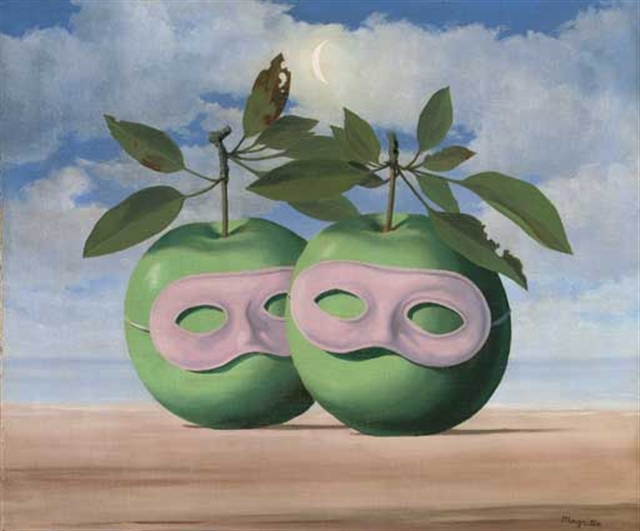
The Married Priest II- (Le prêtre marié) 1961 oil on canvas, Size 18.1 x 21.7 in. / 46 x 55 cm.
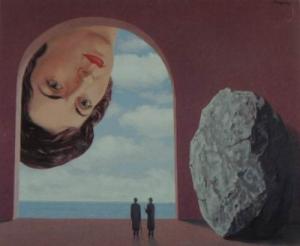
Portrait of Stephy Langui- 1961
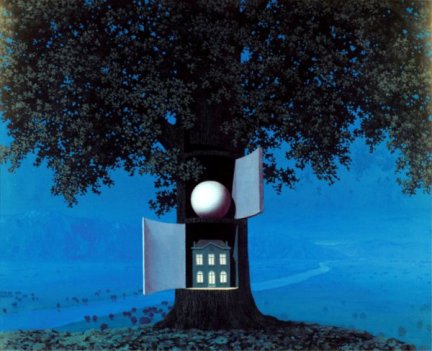
The Voice of Blood III- 1961
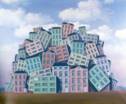
The Breast II- 1961
The Breast features a group of buildings piled up into the form of a breast.
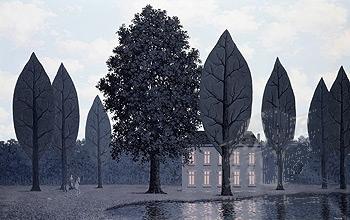
Les Barricades Mysterieuses- 1961
François Couperin's piece for harpsichord, "Les Barricades Mistérieuses" or "Les Barricades Mystérieuses" ("The Mysterious Barricades"), has caught the imagination of many artists, writers and musicians. In the performance, the King's musicians and Marguerite-Louise Couperin (François' sister) wore masks, emphasizing the mysterious presence celebrated by the divertissement, possibly the exiled Stuart James III. Jane Clark suggests that the barricades mistérieuses may refer to these masks (p. 67-8).
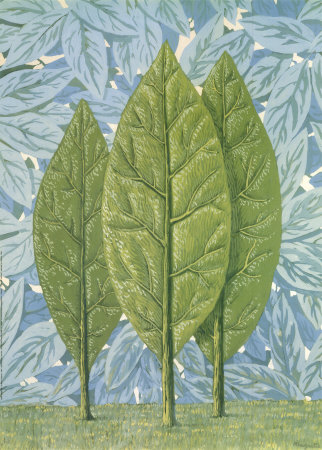
The Good Season (La Belle Saison) 1961
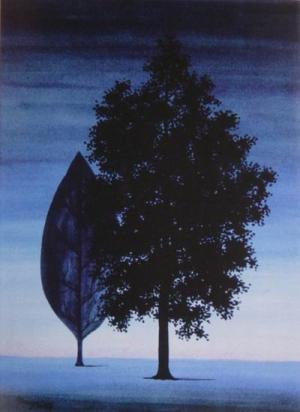
Clairvoyance II (La Clairvoyance) 1962
The first Clairvoyance was done in 1936.
%201962.jpg)
The Straight Path (Le droit chemin) 1962
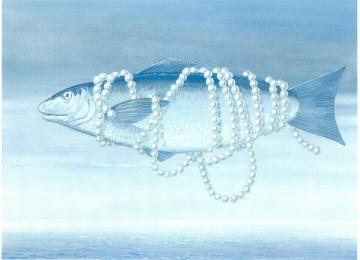
Hommage to Alphonse Allais- 1962, Gauche on paper
Highly regarded by the surrealists, Alphonse Allais (October 20, 1854 - October 28, 1905) was a French writer and humorist born in Honfleur, Calvados. He is the author of many collections of whimsical writings. A poet as much as a humorist, he in particular cultivated the verse form known as holorhyme, i.e. made up entirely of homophonous verses, where entire lines rhyme. For example:
par les bois du djinn où s'entasse de l'effroi,
parle et bois du gin ou cent tasses de lait froid.
Allais is also credited with the earliest known example of a completely silent musical composition. Composed in 1897, his Funeral March for the Obsequies of a Deaf Man -- consisting of nine blank measures -- predates comparable works by John Cage and Erwin Schulhoff by a considerable margin. His piece "Story for Sara" was translated and illustrated by Edward Gorey.
Allais participated in humorous exhibitions, particularly in those of the Salon des Arts Incohérents of 1883 and 1884, held at the Galerie Vivienne. At these Allais exhibited arguably the earliest examples of Conceptual Art. Of his art, perhaps the most influential were his plain white sheet of Bristol paper Première communion de jeunes filles chlorotiques par un temps de neige (First Communion of Anaemic Young Girls In The Snow) (1883), and a similar red work Apoplectic Cardinals Harvesting Tomatoes on the Shore of the Red Sea (Study of the Aurora Borealis) (1884).
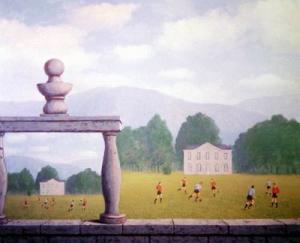
Representation II- 1962
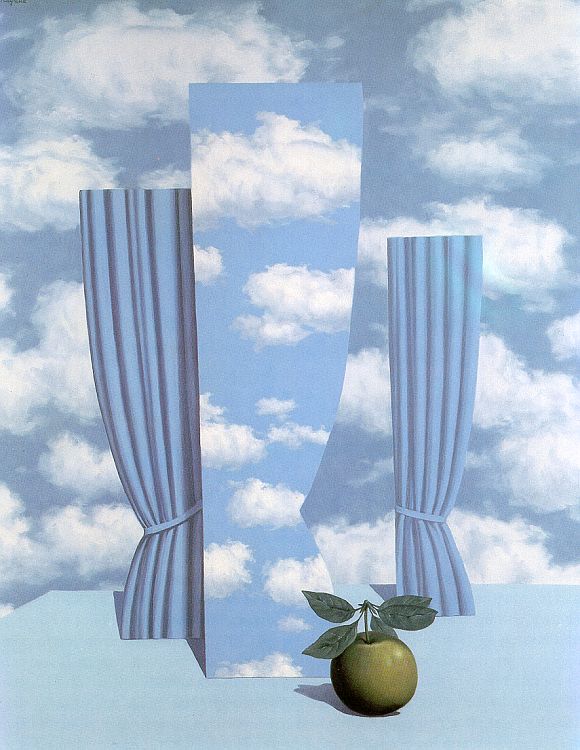
The Beautiful World (Le Beau Monde)1962
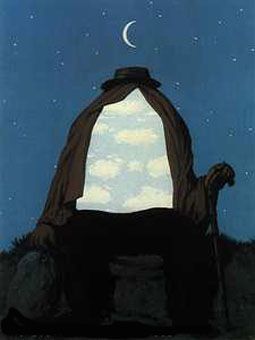
The Therapist II Le Therapeute, 1962
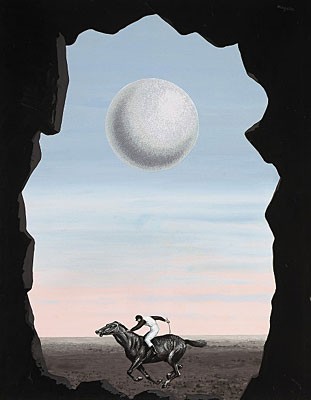
The Lost Jockey III- Le jockey perdu III circa 1962 signed 'Magritte' (upper right) - gouache on paper - 25 1/2 x 19 7/8 in. (64.8 x 50.5 cm.)
This is the third version of the painting Magritte called his "first surrealist" work. The first was a college ala Max Ernst. This one features the jockey riding under an iconic image, the giant sphere.
Provenance: Galleria Internazionale, Milan (no. 166). Acquired from the above by the present owner circa 1960s.
Notes: Le jockey perdu is one of the largest format gouaches by René Magritte, a variation of one of the artist's favourite themes, the crazily displaced horse racing with its rider through an incongruous landscape. In this gouache, Magritte has introduced several other motifs as well: floating above the lost jockey of the title is a mysterious sphere, while the entire scene is shown through a strange, rocky portal, as though the viewer were in a colossal cave at the edge of this flat scrubland.
Magritte first tackled the theme of Le jockey perdu in 1926, a watershed period for the artist, in which he suddendly found a means of exposing the mysteries of the world, the poetic associations between the objects that form our reality and which we take all too much for granted. His strange juxtapositions challenged the viewer, demanding that we consider afresh the properties of the everyday elements of the world around us. So, in this gouache of Le jockey perdu, it can be seen the racetrack that would usually play host to a jockey is absent, the racer taken out of context. At the same time, a strange new planet hovers as though within the atmosphere of the Earth; this ball has replaced the sun and the moon; its looming presence adds a cosmic oddness to the entire picture.
It is a tribute to the importance of this theme that Magritte himself would write, with reference to his original oil of the subject, that 'Le jockey perdu (The Lost Jockey) is the first canvas I really painted with the feeling I had found my way, if one can use that term' (R. Magritte, quoted in H. Torczyner, Magritte: Ideas and Images, translated by R. Miller, New York, 1977, p. 48). Magritte's own revelation had occurred when he had seen a painting by Giorgio de Chirico. Presenting the viewer with an eccentric assortment of seemingly unassociated objects, de Chirico's Le chant d'amour introduced the viewer to a realm in which another hidden logic appeared dominant. While the mysticism of de Chirico did not influence Magritte, the break with perceived reality and the use of juxtapositions did. For this reason, Magritte denied the open influence of de Chirico, making specific reference to his first version of Le jockey perdu:
'If one takes into consideration what I've painted since 1926 (Le jockey perdu-1926-- for example, and what followed), I don't think one can talk about 'Chirico's influence' I was 'struck' about 1925 when I saw a picture by Chirico Le chant d'amour. If there is any influence it's quite possible there's no resemblance to Chirico's pictures in Le jockey perdu. In sum, the influence in question is limited to a great emotion, to a marvellous revelation when for the first time in my life I saw truly poetic painting. With time, I began to renounce researches into pictures in which the manner of painting was uppermost. Now, I know that since 1926 I've only worried about what should be painted. This became clear only some time after having 'instinctively' sought what should be painted' (R. Magritte, quoted in ibid., p. 258).
As in several of Magritte's strongest works, Le jockey perdu is made all the more visually striking by the contrast between stillness and dynamism, here articulated by the difference between the speed of the jockey and the emptiness of the landscape around him. Where de Chirico's works were often marked by an intense sense of poise and stillness, Magritte has prompted the viewer into a profound investigation of everyday elements, items and qualities from the world around us such as movement, horses, gravity and the celestial bodies.
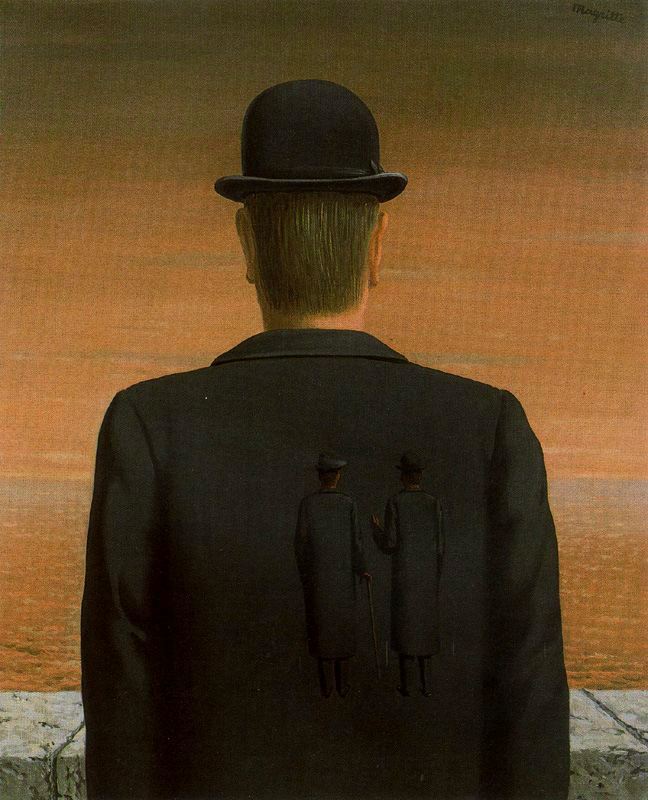
The spirit of Adventure 1962
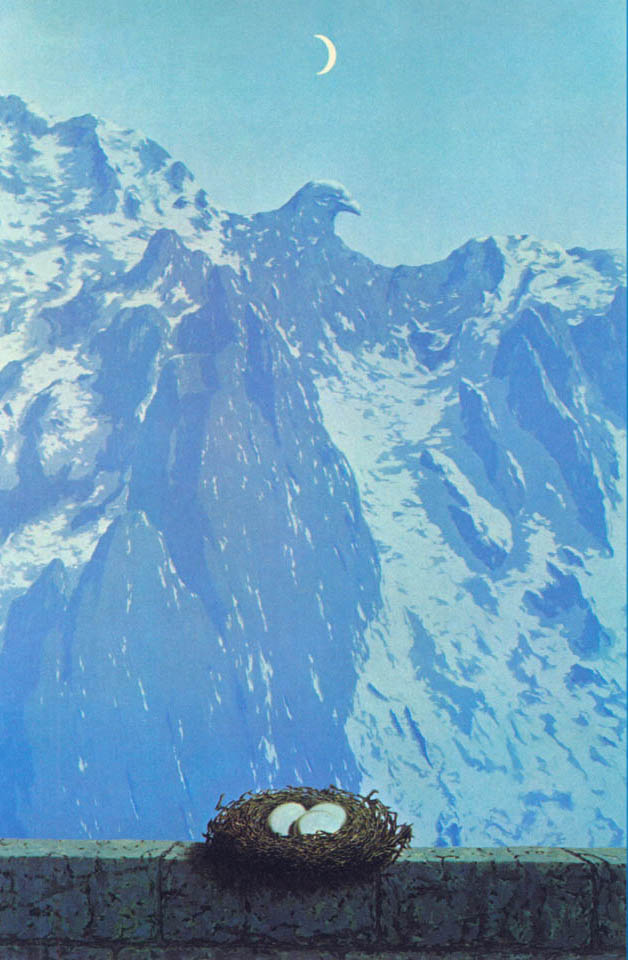
Domain of Arnheim 1962
This is last version of his famous painting titled after an Edgar Allen Poe story.
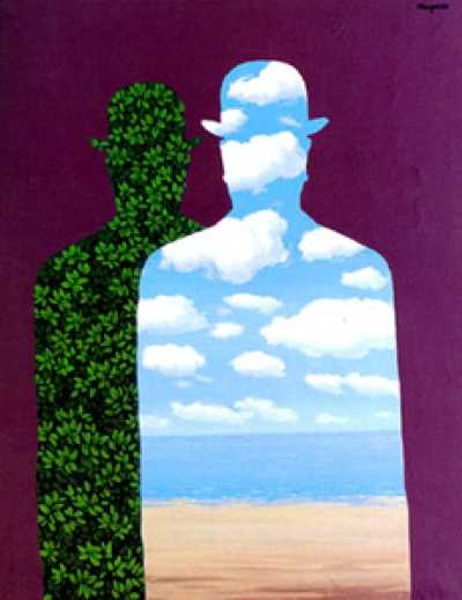
High Society (Le Beau Monde) 1962
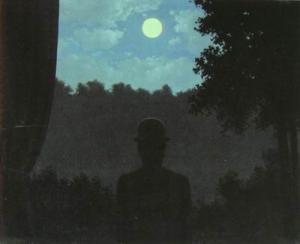
Towards Pleasure (A la Recherche du plaisir) 1962
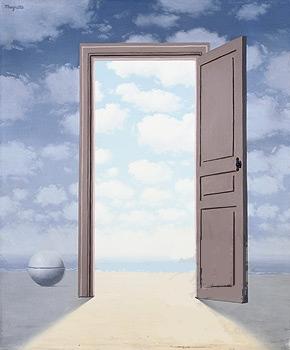
The Improvement (L'embellie) 1962
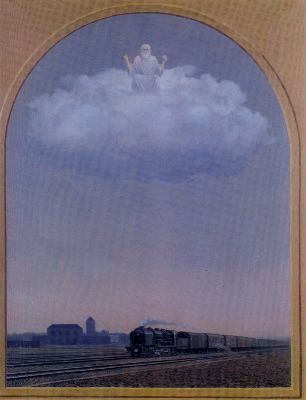
The Nightingale 1962
One of several paintings with religious themes. I believe that Magritte. a professed agnostic in keeping with his rejection of organized religion, was secretly religious. Later in life he painted several "religious" paintings. Here God sits on a cloud above a train.
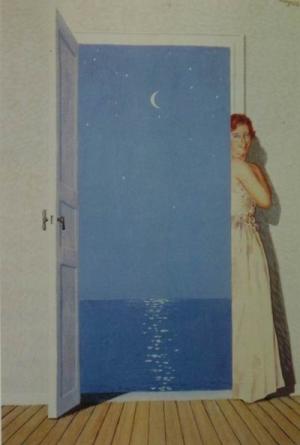
Portrait of Germaine Nellens- 1962
In 1951 Gustave Nellens commissioned Magritte to paint (actually he supervised other painters who copied his designs) the large eight murals at Casino gaming room at Knokke-Le Zoute in Belgium. Surely this is a portrait of Gustave Nellens wife or daughter. I need corroboration.
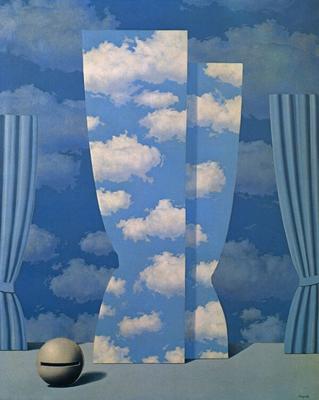
The Wasted Effort (La peine Perdue) 1962
According to Harry Torczyner this cryptic title refers to an old street in Brussels named "La Peine Perdue" but because of a bad experience was renamed "Le Pain Perdu."
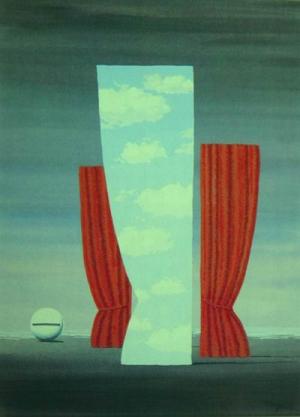
Mona Lisa- circa 1962
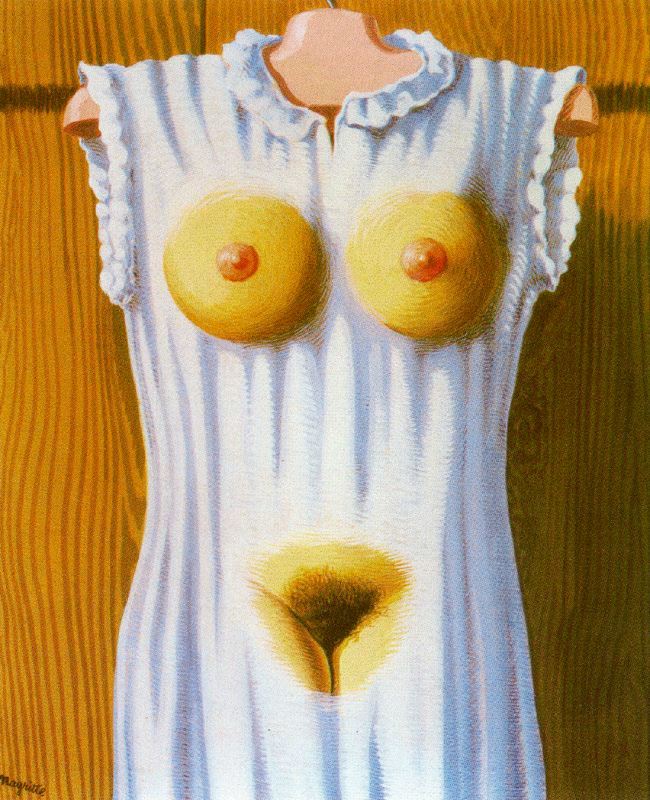
The Philosophy in the Bedroom II 1962
This is the second version of Philosophy in the Bedroom, a title by Marquise de Sade.
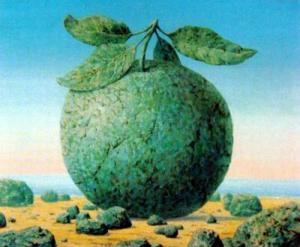
The Great Table 1962-63
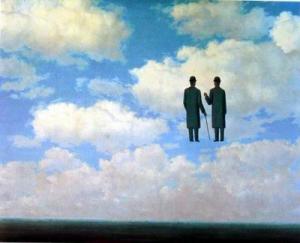
Reconnaissance without End (La Reconnaissance infinie) 1963
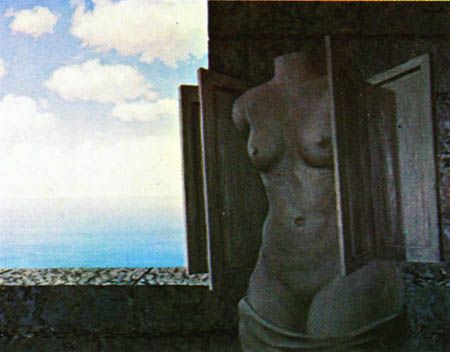
The Flying Statue 1963
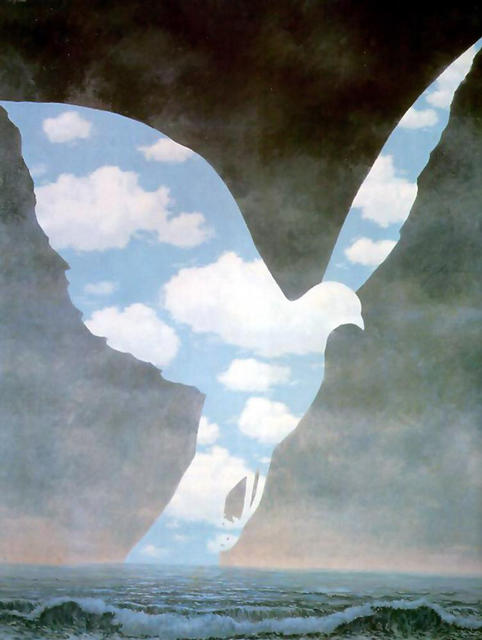
The Large Family (La Grande Famaille) 1963
Magritte used similar cutout devises many times like The Promise.
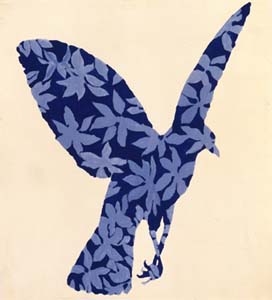
La Grande Famille variation
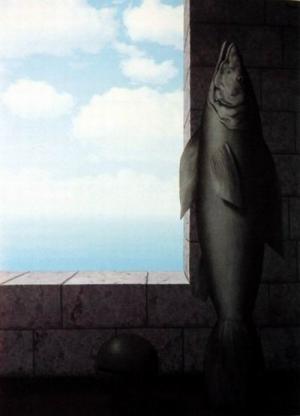
The Search for Truth (La Recherche de laverite) 1963
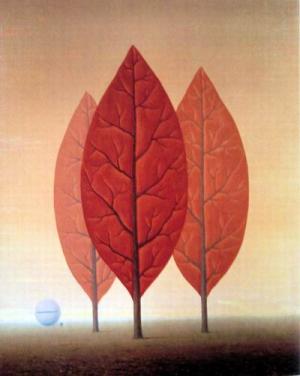
The Princes of Autumn (Les Princes de l'automne) 1963
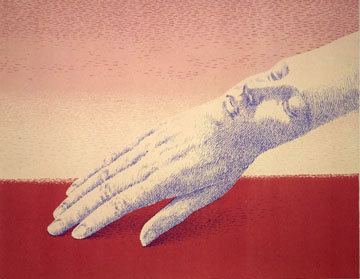
The Indescreet Jewels (Les Bijous Indiscrets) 1963
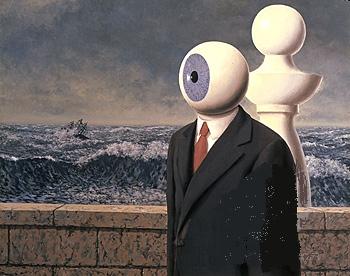
The Difficult Crossing II (La Traversee Difficile) 1963
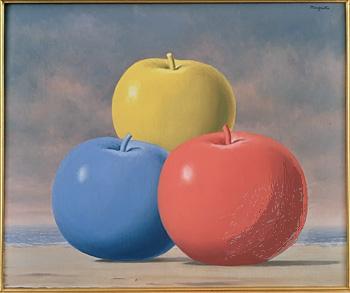
The Song of Love I (Le Chant d'Amour) 1963
The Song of Love (also known as Le chant d'amour or Love Song) is the same name as the De Chirico painting that inspired Rene in the early 1920s.
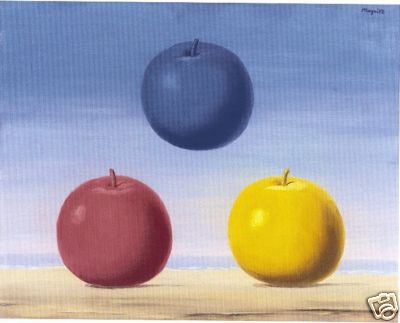
Young Love I (Les Jeunes Amours I) circa 1963
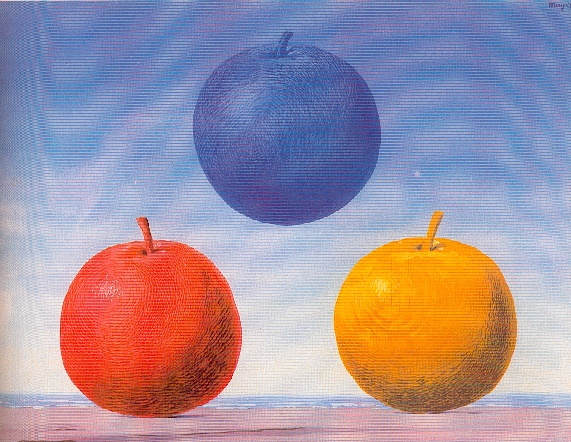
Young Love II (Les Jeunes Amours II) circa 1963
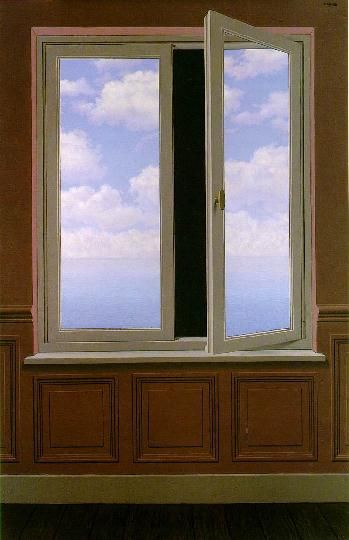
The Looking Glass (La Lunette d'approche) 1963
Also incorrectly named called "The Field Glass" or "The Telescope" this painting shows the opening between the mirror that Alice traveled through. Through the Looking-Glass, and What Alice Found There (1871) is a work of children's literature by Lewis Carroll (Charles Lutwidge Dodgson), generally categorized as literary nonsense but the books received cult status by the surrealistists who treasured nonsense.
Through the Looking-Glass is the sequel to Alice's Adventures in Wonderland (1865). Although it makes no reference to the events in the earlier book, the themes and settings of Through the Looking-Glass make it a kind of mirror image of Wonderland: the first book begins outdoors, in the warm month of May, on Alice's birthday (May 4), uses frequent changes in size as a plot device, and draws on the imagery of playing cards; the second opens indoors on a snowy, wintry night exactly six months later, on November 4 (the day before Guy Fawkes Night), uses frequent changes in time and spatial directions as a plot device, and draws on the imagery of chess.
Magritte, who was an avid chess player, was drawn to Carroll's works and references him in both "Alice in Wonderland and "The Empire of Light."
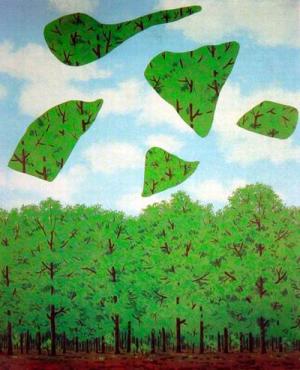
Chorus of the Sphinx (Le Chceur des sphinges) 1964
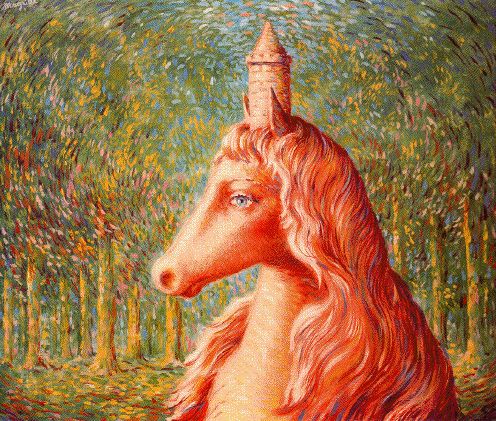
The Fine Idea (La Belle Idée) 1963-64
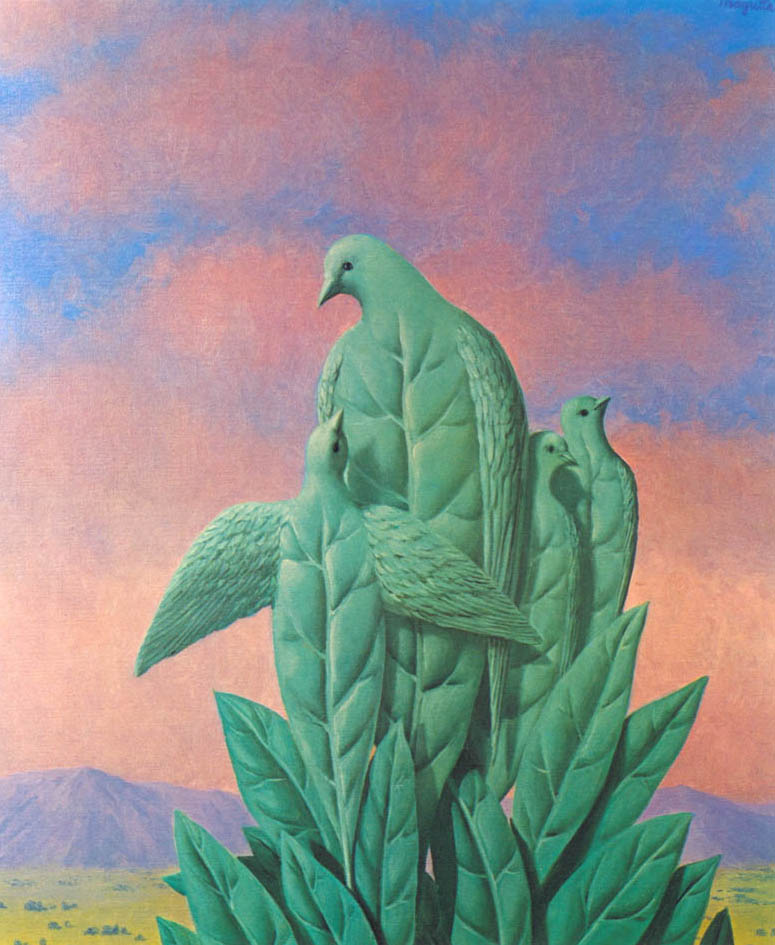
Natural Thanks (graces) II, 1963
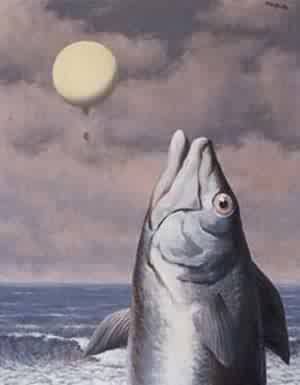
Le Grand Air, 1963-64
.jpg)
This is not an Apple 1964
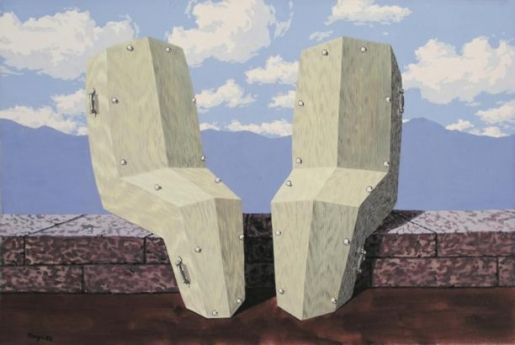
In a beautiful late afternoon (Par un belle fin d’apres-midi) 1964
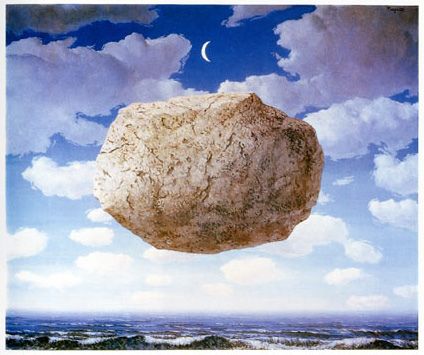
Zeno's Arrow (La Fleche de Zenon) 1964
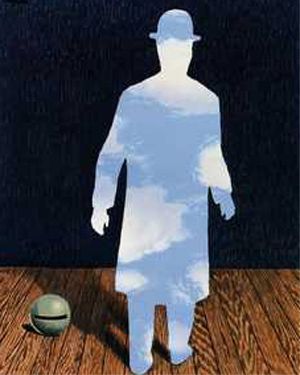
Le Journal Intime, 1964
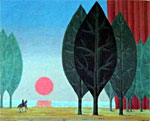
Forest of Paimpont (La Foret de Paimpont) 1964
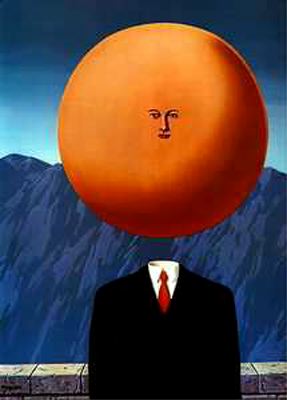
The Art of Living II- 1964
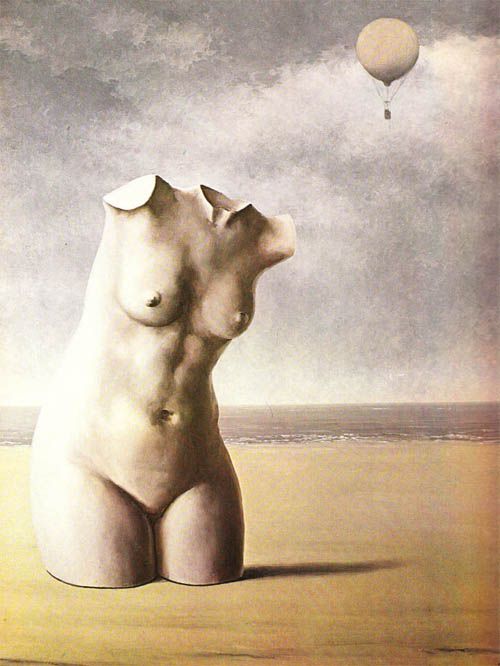
When the Hour Strikes (Quand l'heure sonnera) 1964-65
When Magritte was a child one of his most vivid memories was when a manned hot air ballon landed on his house. He used this balloon image in one of his first paintings in the new style in 1925, The Blue Cinema. Since his idol De Chirico also use the hot air ballon image it's hard to tell whether Magritte took the image from De Chirico or his childhood. The Venus de Milo statue image (The Copper Handcuffs- 1931), is in almost the exact the same pose as Magritte's The Beauty of Night (la Belle de Nuit) 1932.
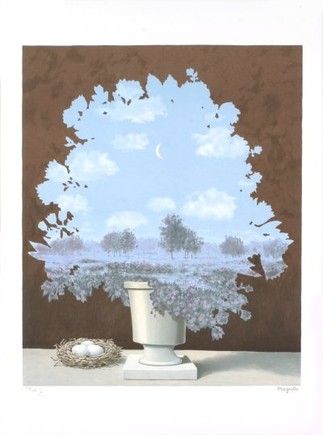
The Land of Miracles (Le Pays des Miracles) 1964
The Land of Miracles is the last version of Le Plagiat (The Plagiarism) featuring a cut-out of a vase of flowers first done in 1939-40, that Magritte made. It's very close to the 1939 version, except the scene is slightly different.
.jpg)
The Son of Man 1964
I tend to all the psychoanalitic theories surrounding this famous painting regarding the biblical symbol of the apple. Magritte used different object to obscure faces in his later years including a bird, flowers and a pipe. Certainly the other items don't refer to the bible.
It's the title that throws interpreter off- The Son of Man. Magritte used titles to create more enigmas and also as puns but the Son of Man doesn't have to mean this is a religious painting. Here what the artist said about his painting.
The Son of Man according to Magritte, "At least it hides the face partly. Well, so you have the apparent face, the apple, hiding the visible but hidden, the face of the person. It's something that happens constantly. Everything we see hides another thing, we always want to see what is hidden by what we see. There is an interest in that which is hidden and which the visible does not show us. This interest can take the form of a quite intense feeling, a sort of conflict, one might say, between the visible that is hidden and the visible that is present."
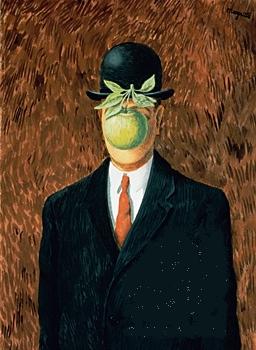
The Taste of the Invisible 1964
The Taste of the Invisible is a variation of the Son of Man above.
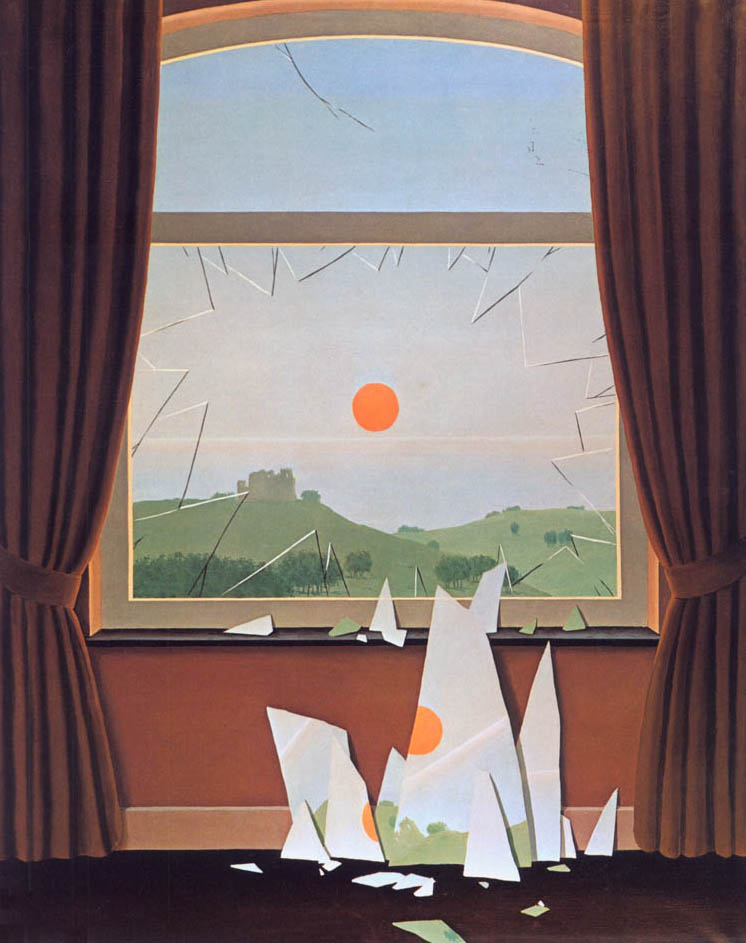
Evening Falls II (Le Soir qui tombe) 1964
Evening falls is a variation of The Domain of Arheim II where the shattered glass even when broken still contains the image that you see through the window.
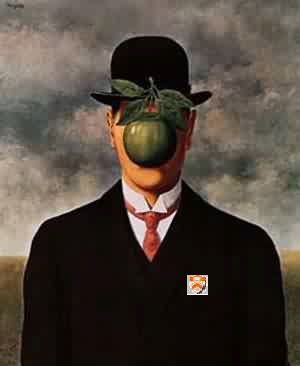
The Great War I (La Grande Guerre)
A variant of the Son of Man this paitning has the same title and the next painting.
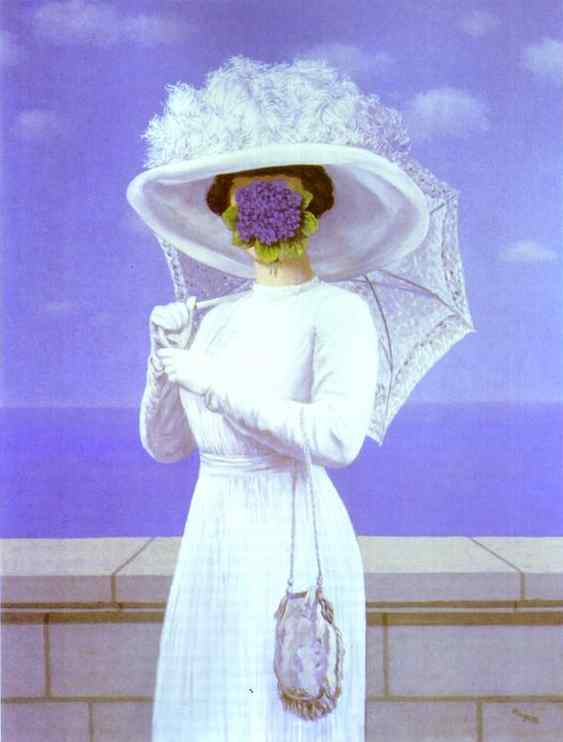
The Great War II- 1964
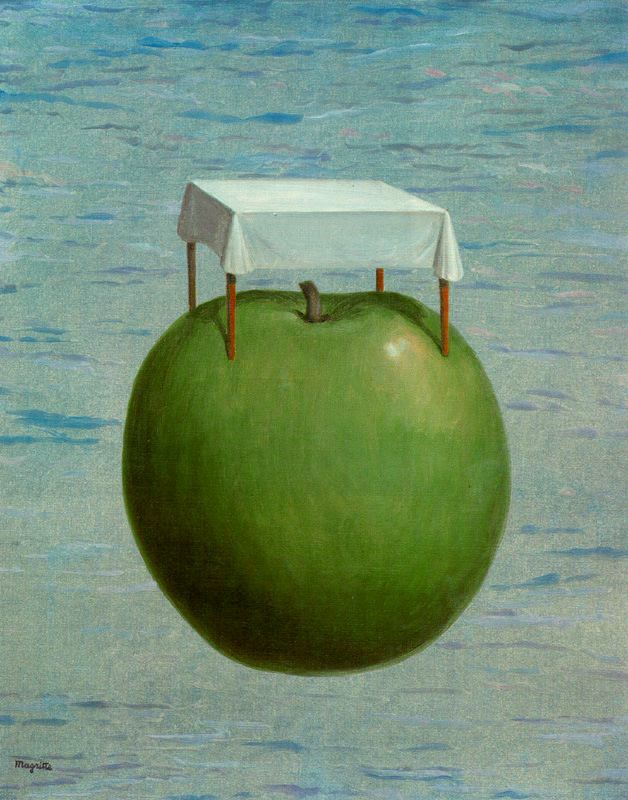
Fine Realities 1964
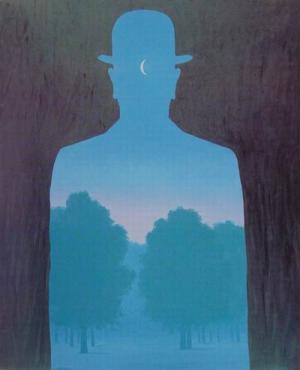
A Friend of Order (L'Ami de l'ordre) 1964
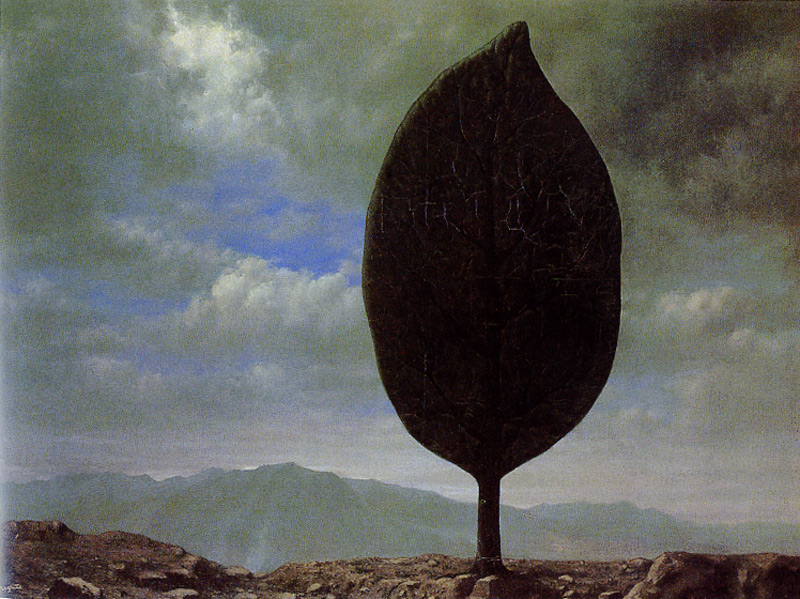
Plain of Air II- 1964
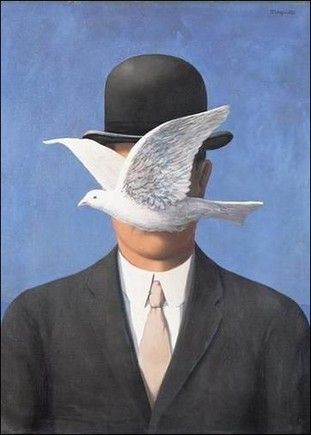
The Man in the Bowler Hat (L’Homme au Chapeau Melon) 1964
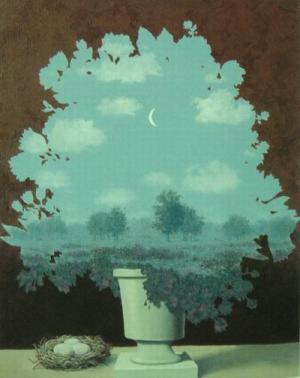
The Land of Miracles -1964
The Land of Miracles is a variation of Le Plagiat (The Plagiarism) done in 1939-1940 and again around 1960. This time he uses a different name and slightly different scene although the bird eggs and next remain the same.
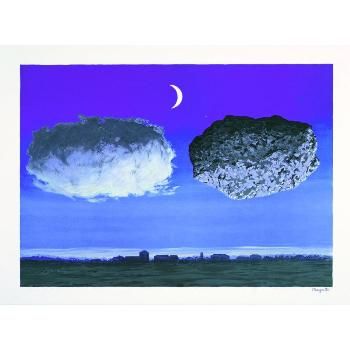
The Battle Of Argonne II (La Bataille de l'Argonne) Lithograph- 1964
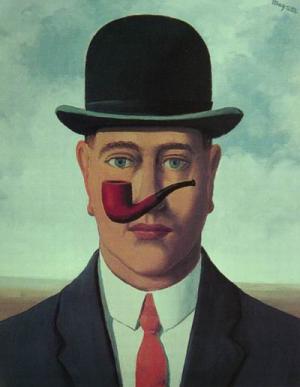
Good Faith (La Bonne Foi) 1964-65
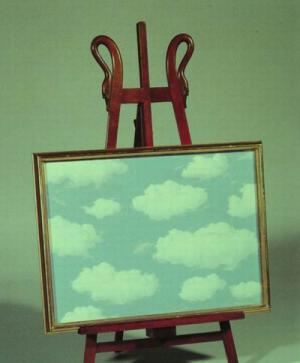
The Somersault (Le Saut perilieux) 1964-65
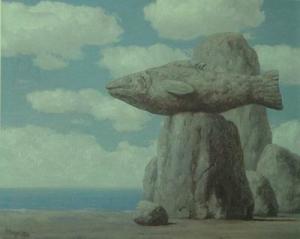
Connivance La Connivence, 1965
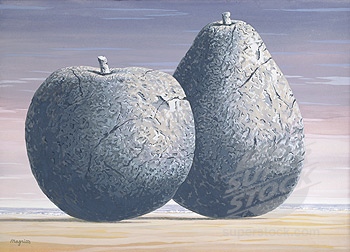
The Great Table (La Grande Table) ca. 1965
La Grande Table is an extention of Magritte's pertrified objects that he started in the late 1940s with The Legend of the Centuries (La leyenda de los siglos) 1948. In his Memory of a Journey paintings the entire scene is pertified (turned to stone). Here it's just a giant apple and a pear.
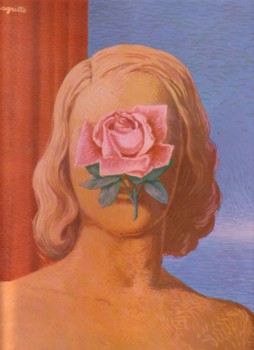
XXe Siecle Cover- Magritte 1965
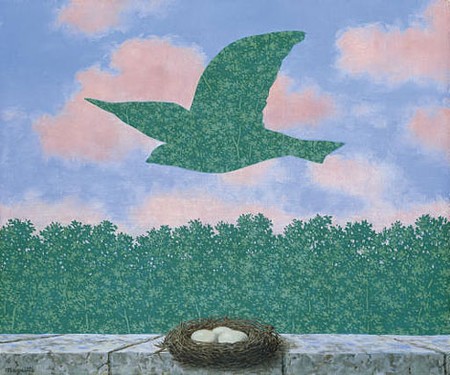
The Spring (Le Printemps) 1965 signed 'Magritte' (lower left) - oil on canvas - 18 1/8 x 21 5/8 in. (46 x 55 cm.) - Painted circa 1965 - Provenance: Galerie Isy Brachot, Brussels. Acquired from the above by the present owner in 1968.
Literature: S. Alexandrian & P. Waldberg, René Magritte, Paris, 1970 (illustrated p. 51).
J. Meuris, René Magritte 1898-1967, Cologne, 1990 (illustrated p. 141).
J. Meuris, Magritte, New York, 1991, no. 252 (illustrated p. 170).
D. Sylvester (ed.), René Magritte: catalogue raisonné, vol. III, Oil Paintings, Objects and Bronzes 1949-1967, Antwerp, 1993, no. 1016 (illustrated p. 412).
Exhibited: Brussels, Galerie Isy Brachot, Art sans frontières IV, December - 1968 - January 1969, no. 75.
Cologne, Galerie Gmurzynska, Ensor, Delvaux, Magritte..., March - April 1969 (dated '1965').
Lausanne, Fondation de l'Hermitage, René Magritte, June - November 1987, no. 115.
Munich, Kunsthalle der Hypo-Kulturstiftung, René Magritte, November 1987 - February 1988, no. 127 (illustrated).
Notes: Caught in the air, flying above a nest filled with eggs, a bird is shown against the backdrop of a pleasantly cloud-specked sky. And yet the bird is a silhouette, a cut-out, its shape filled with a foliage that appears to be a continuation of the woodland in the background in the lower portion of the painting. This picture is filled with the strangeness and poetry so unique to the vision Magritte.
By the time Le printemps was painted, circa 1965, Magritte had long been filtering the visual world from his unique perspective, taking the simple elements and assumptions from everyday life and converting them, twisting them, giving them just enough of a nudge and a disruption that they would take on new qualities. In this picture, Magritte has chosen a selection of simple elements bird, trees, eggs and reconfigured their properties to marvellous effect. In turn, the genuine world of visual impetus surrounding the viewer regains some of its poetry and mystery - when next we see a bird, we no longer take for granted the strangeness of its ability to fly or the uniqueness of its appearance. Le printemps has been painted in such a way as to give a sense of stillness, even contemplation, that is deliberately at odds with the dynamism of flight; the trees, too, which comprise the bird's body imply rootedness and therefore stillness. They imply a link to the ground which is not there, Magritte presenting the viewer with a range of paradoxes, riddles to which there is no true answer and which beg us only to look upon the world around us as a riddle, a source of mystery and wonder.
Magritte himself explained that the elements that comprise his works are not stand-ins for other meanings, are not products of the worlds of dream and the subconscious that had so fascinated other artists associated with the Surreal. 'In the images I paint, there is no question of either dream, escape, or symbols,' Magritte explained.
'My images are not substitutes for either sleeping or waking dreams. They do not give us the illusion of escaping from reality. They do not replace the habit of degrading what we see into conventional symbols, old or new.
'I conceive painting as the art of juxtaposing colours in such a way that their effective aspect disappears and allows a poetic image to become visible. This image is the total description of a thought that unites-- in a poetic order-- familiar figures of the visible: skies, people, trees, mountains, furniture, stars, solids, inscriptions, etc. The poetic order evokes mystery, it responds to our natural interest in the unknown.
'Poetic images are visible, but they are as intangible as the universe. These poetic images hide nothing: they show nothing but the figures of the visible. Painting is totally unfitted for representing the invisible, that is, what cannot be illuminated by the light: pleasure, sorrow, knowledge and ignorance, speech and silence, etc.
'After having attempted to understand non-traditional painting, we admit that it cannot be understood. In any case, we are not assuming any serious responsibility: we do not have to know or to learn anything. Imaginary irrationality is futile and boring. However, we can understand poetic thought by making it a part of ourselves and by taking care not to remove from the known the unknown elements it contains' (R. Magritte, quoted in H. Torczyner, Magritte: Ideas and Images, translated by R. Miller, New York, 1977, p. 224).
In Le printemps, it is clear, then, that the bird, the eggs, the woodland are not symbols, but are there representing themselves, bringing to light their own particularities and peculiarities, making us all the more aware of their singular properties, in short, forcing the viewer to contemplate the 'unknown elements' that they contain.
During Magritte's career, he became increasingly adept at converting his vision of the mysteries of the world into pictures that, through their iconic simplicity, conveyed their messages all the more strikingly. Where some of his earlier Surreal pictures had a wealth of details and juxtapositions, from the 1930s onwards, he pared back the elements, making each one pack a far greater punch. It is in its simplicity that Le printemps gains its strange, distinctive, revelatory power. By limiting himself to only a few elements bird, sky, nest, parapet, woodland Magritte succeeds in presenting the viewer with a concise range of objects and, crucially, a concise range of the relationships between them. The sense of impossibility within the realm of this Magrittean epiphany is exemplified by the interplay between, for instance, the egg-filled nest and the foliage-bird-- could such a strange, two-dimensional, cut-out bird have laid eggs? This quandary recalls the stone eagle shown above a parapet furnished with an egg-filled nest in Le domaine d'Arnheim. Where in that work, the bird is made of mountain, in Le printemps the eggs appear (within the two-dimensional world of the picture) three-dimensional, painted in the round as opposed to the silhouette-like bird. The interplays between the elements in this painting even throw the sky itself into question. After all, if the bird is a cut-out, are the trees behind the sky? It is confronting us with these simple, sometimes discreet interplays, juxtapositions, relationships, contrasts and comparisons, with incongruities and incompatibilities, that Magritte prompts us towards a more awe-filled appreciation of the world.
In the 1930s, many of Magritte's pictures dealt with problems and questions, riddles posed by simple elements such as the door, the window, the sea, the horse... In a sense, flight and the bird are the 'problems' that Magritte has attempted to solve in Le printemps. However, these 'problems,' as Magritte was at pains to point out, 'are not themes. These are images that come together, that impose themselves upon me. Always images of the simplest objects, those anyone can see around him: a hat, a bell, an apple, an easel, a bird, a street lamp, a brick wall, shoes, a three-piece suit. Except that sometimes the hat is resting on the apple, the bird is made of stone, the shoes are feet with real toes, the brick wall takes the form of a desk, and the three-piece suit is really a pleasant valley. These ideas for combining images occur to me without my looking for them' (Magritte, quoted in ibid., p. 202). This statement is important as it reveals the extent to which inspiration, pure and simple, would provide Magritte's pictorial solutions. These were ideas that would occur to the artist, not as the result of active investigation, but instead as miniature revelations.
Many of Magritte's pictures, especially his iconic La trahison des images, in which a painting of a pipe was accompanied by a caption stating that this was not a pipe, deal with the properties and limitations of the act of representation. The picture of a pipe clearly is not a pipe, as Magritte pointed out. In Le printemps, Magritte appears to question the nature of the two-dimensional representation of the three-dimensional world in part through the visual puzzle with which the viewer is presented, and also through the deliberate cut-out appearance of the bird itself. Is Magritte deliberately pointing out the flatness of painting in comparison to the 'depth' of the real world? Is he implying that another dimension lies beyond our grasp, beyond the veil of our prosaic, habit-numbed appreciation of the world around us?
The interplays in Le printemps are brought into bolder relief by the title, which reinforces the notions of the verdant foliage, life, birth and rebirth introduced by the various elements depicted. Magritte's titles, which were sometimes suggested by his friends rather than being integrally linked to his works, are nonetheless evocative, and he was well aware of the way in which they could add an extra dimension to his works, an extra layer of questioning, an extra layer of interpretation, or to be interpreted. As he himself stated, 'The titles of my paintings accompany them like the names attached to objects without illustrating or explaining them' (R. Magritte, letter to Barnet Hodes, 1957, quoted in ibid., p. 203).
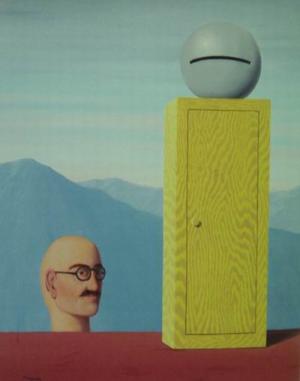
Discourse on Method- 1965
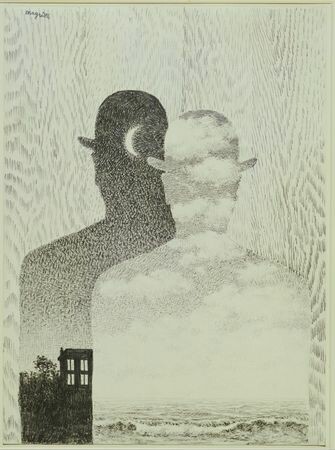
The Thought Which Sees- 1965
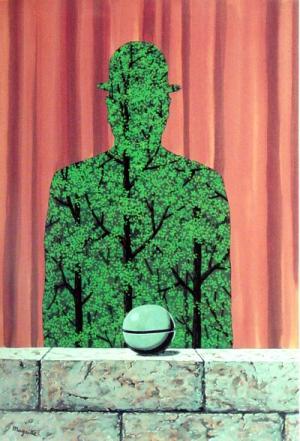
The Man and the Forest (L'Honitneet la foret) 1965
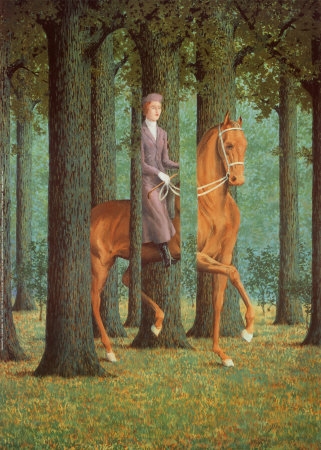
The Blank Signature (La Carte Blanche) 1965
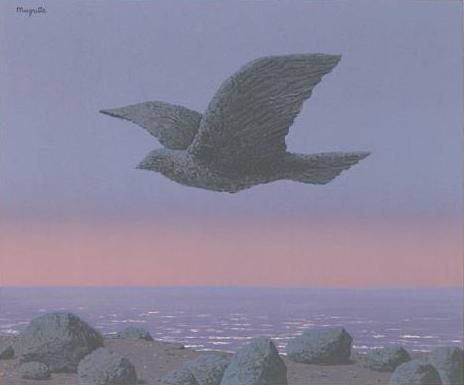
The Idol (L’Idole) 1965
This is an litho image from a poster. It's based on his famous painting "The Promise."
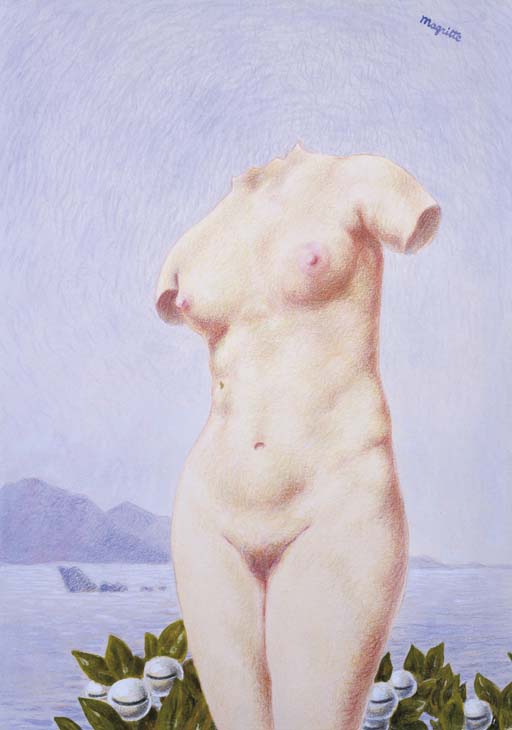
The Vision (La clairvoyance) 1965 signed 'Magritte' (upper right); inscribed 'La Mémoire' (on the reverse); signed, titled, dated and inscribed '"LA CLAIRVOYANCE" MAGRITTE 1937 cordialement à Michel et Roger Stallaerts René Magritte juillet 1966' (on the reverse of the frame) gouache, colored crayon and pastel on paper 16½ x 11 5/8 in. (42 x 29.5 cm.) Executed in 1965
Provenance: Margaret Krebs, Brussels (probably acquired from the artist). Private collection, Brussels (acquired from the above circa 1966). Anon. sale, Sotheby's, London, 3 February 2004, lot 67. Acquired at the above sale by the present owner.
Literature: Letter from Magritte to Kahmen, 27 January 1965, in Magritte Ecrits, p. 177; D. Sylvester, ed., René Magritte, catalogue raisonné, London, 1994, vol. IV, p. 281, no. 1578 (illustrated in color; with incorrect dimensions).
Exhibited: Paris, Galerie d'Orsay, Les Peintres Surréalistes. Delvaux, Ensor, Labisse, Magritte..., 1999, no. 10 (illustrated in color).
Notes: A torso, without arms or head, poses before an idyllic landscape reminiscent of a Mediterranean island. The torso is no sculptural fragment, though, but appears to be made of living, breathing impossible flesh. In La clairvoyance, executed in 1965, Magritte has portrayed the historical world of ancient Greece that produced the fragmentary statuary that fills so many museums as a place inhabited by a fragmentary woman. This is a retrospective justification, perversely implying that the armless and headless statues that we see today were taken from life--that they are the result of design and not hazard. In this assault on our customary understanding of our universe and its laws and rules, Magritte demands that his viewer take a fresh view at the reality to which we are all too accustomed, peeling the scales from our eyes to reveal the everyday world as a place of infinite hidden wonders.
In 1965, Volker Kahmen had suggested that Magritte create an image of the Vénus de Milo as though it were made of the granite that features in many of the Belgian artist's images. Instead, Magritte wrote back with a better idea, explaining that he would portray the statue as though it were made of flesh: "The sudden absence of stone, where stone really exists, and the presence, however, of the form that the stone embodied, must necessarily evoke a sense of mystery. 'The 'nature' of such a statue would not thereby be made arbitrary or subject to a whim: it is necessary that it should be flesh" (Magritte, quoted in D. Sylvester, René Magritte Catalogue Raisonné, Vol. IV, London, 1994, p. 281).
Magritte has thereby created an absorbing surreal vision that blurs the boundaries of art and reality, hinting at the subtle magic of the relationship that links them. The use of one of the most iconic sculptures in the world is a spur to our confused recognition. However, it is interesting to note that in La clairvoyance, Magritte has tailored the sculpture to his own uses, reinventing it not only through the use of flesh instead of stone, but also by removing the head and the drapery of the original, making the impossible appearance of a living flesh fragment all the more incongruous and affecting.

The Open Door (La Porte Ouverte,) 1965
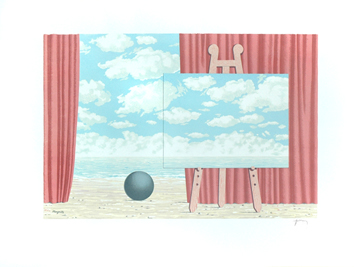
Fair Captive (La Belle Captive) 1965
This is a lithograph that is based on Human Condition II done in 1935.
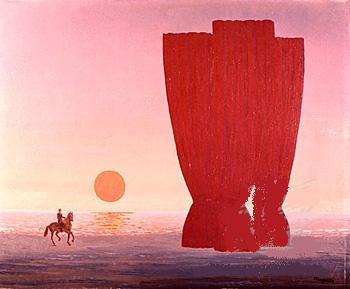
The Organs of the Night (Les Orgues de la Soiree) 1965
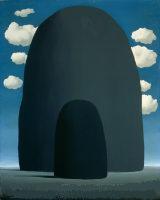
Among the groves legers (Parmi les bosquets legers) 1965
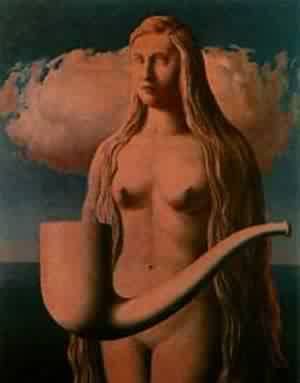
The Masque of the Lightning (Le Masque de la Foudre) 1965-66
Near the end of his life (he died in 1967) Magritte realized that his "La Pipe" image was hopelessly out-of-date. Most people didn't smoke pipes anymore as was fashionable in the 1920s when Magritte's famous "This is Not a Pipe" painting became an international hit.
.jpg)
Ad for Sabena (1966)
The next two images (same painting) are based on "The Promise." The first appeared in an ad for Sabena. The next titled Sky Bird is a photo of the actual painting.
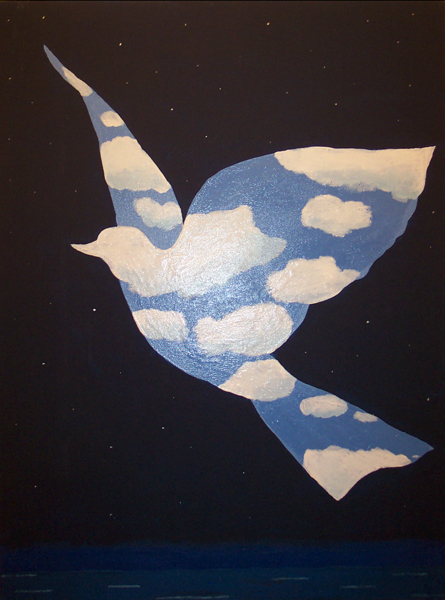
The Sky Bird 1966

The Devil's Smile (Le sourire du diable) 1966
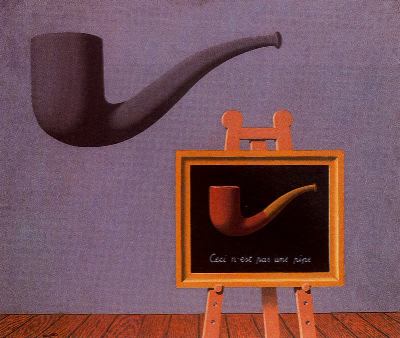
The Two Mysteries 1966
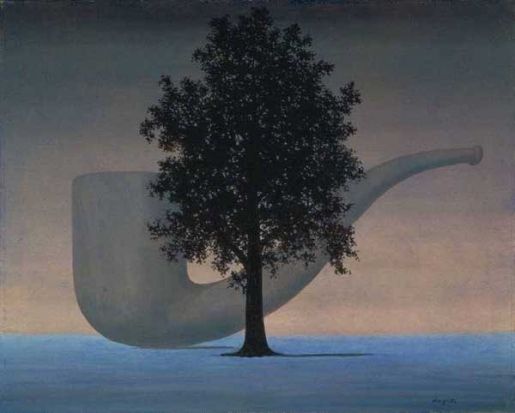
The Shadows (Les Ombres) 1966
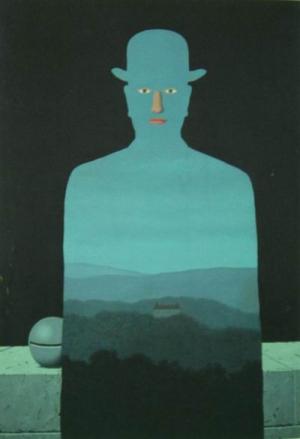
The King's Museum (Le Musee du roi) 1966
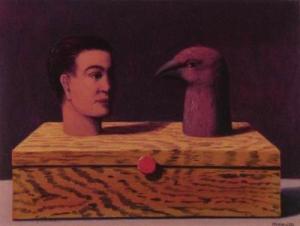
Gem Stones Les Pierreries, 1966
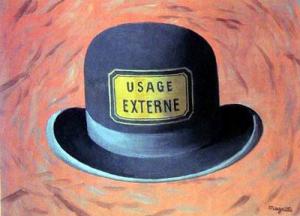
The Horrendous Stopper (Le Bouchon d'epouvante) 1966
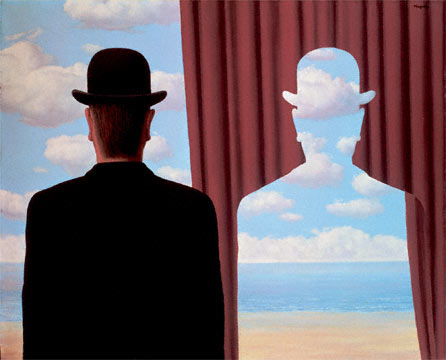
Decalcomania, 1966
Decalcomania is the process of transferring pictures or designs printed on specially prepared paper to materials such as glass or metal, such as adding a decal.
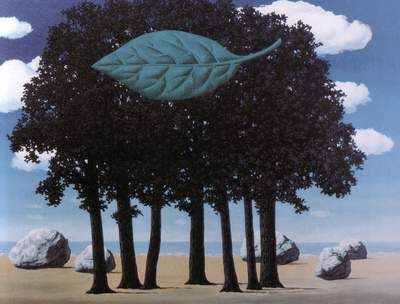
Tables of the Law (Les tables de la loi) 1966
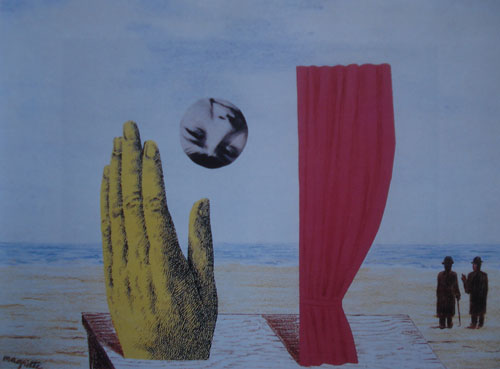
Collage 1966
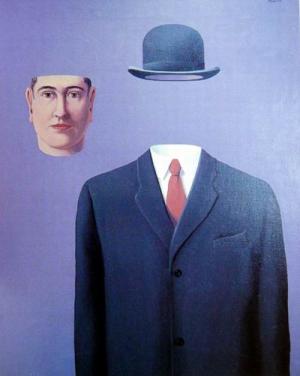
The Pilgrim (Le Pelerin) 1966
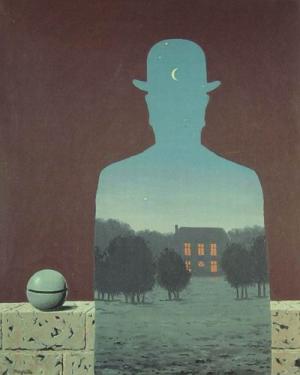
The Happy Donor (L'Heureux Donateur) 1966

The Endearing Truth 1966
I believe that, despite his agnostic protestations, Magritte was secretly religious. This painting done shortly before his death when he knew he was dying of cancer seems to confirm my suspicions. The image of a table is painted like a fresco on a wall. In what other famous religious painting does this happen? Leonardo's Last Supper of course. The trick Magritte presents is...Christ and his disciples are missing. Magitte confirms this in a letter to Bosman written while the Magritte's were in Milan, "We have seen Leonardo's Last Supper, very badly damaged by time and the American bombings. The Last Supper gives me an idea fro a painting."
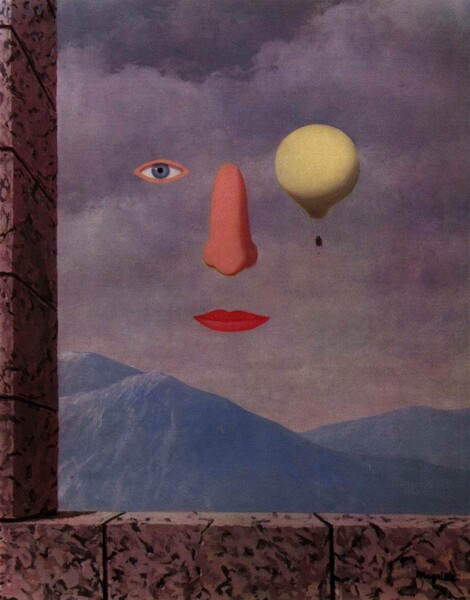
The Age of Enlightenment (Le Siècle des Lumières) 1967
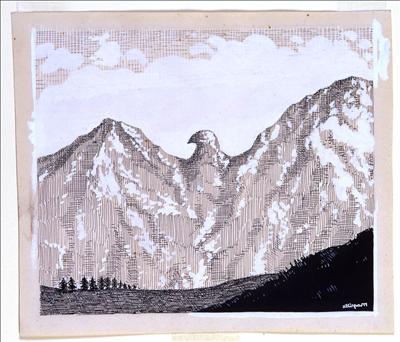
Domain of Arnheim Variant (mountain eagle) 1967
.jpg)
The Beautiful Relations 1967
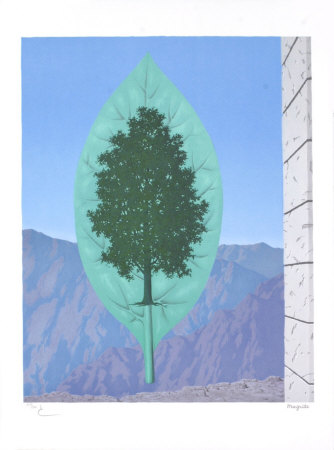
The Last Cry (Le Dernier Cri) 1967 litho
%201967.jpg)
The Blank Page (La Page Blanche ) 1967
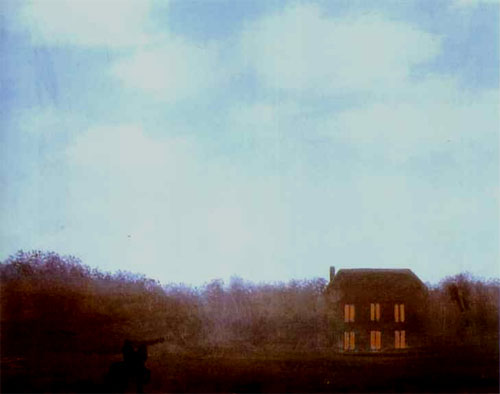
The Empire of Lights (Unfinished) 1967
Magritte continued painting until 1967, the year of his death, leaving an unfinished painting (above). The work had been commissioned by a young German collector from Cologne, who wanted "something in the nature of Empire of the Lights; he was destined never to take possession of the picture he had ordered. The uncompleted painting would remain on its easel in the painter's house in Brussels until the death of Georgette Magritte in 1986.